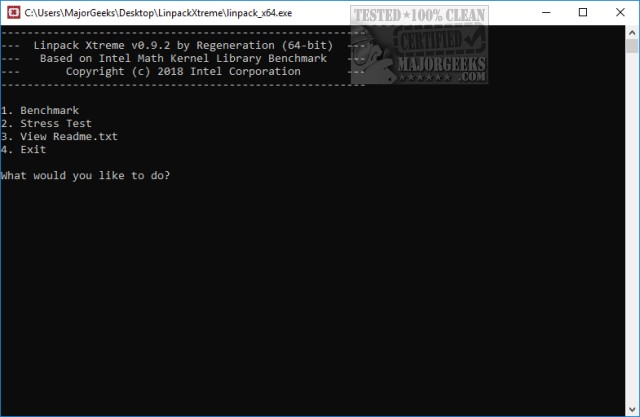
- #LINPACK BENCHMARK INFORMATION PDF#
- #LINPACK BENCHMARK INFORMATION FULL#
- #LINPACK BENCHMARK INFORMATION SOFTWARE#
- #LINPACK BENCHMARK INFORMATION CODE#
That would be more logical, I suppose, but I expect the organizers would be reluctant to do that, given people’s hunger for big numbers, now squarely in the petaflop range for supercomputers and soon to flirt with exaflops. If that’s true, maybe the TOP500 organization should be using HPCG for its main ranking. I don’t have statistics to back me up, but I suspect the distribution is skewed closer to the HPCG side of the shelf. So are the LINPACK (HPL) results or the HPCG results more representative of real-world operations? Experts regard them as “bookends,” bracketing the range users of these supercomputers can expect to experience. So running many problems on the Sunway TaihuLight is like getting into a Dodge Viper, which can in theory go 200 miles per hour, and never driving it any faster than a Galapagos tortoise. That’s just 0.4 percent of the computer’s theoretical performance. But with the HPCG benchmark, it achieves a mere 481 teraflops. Judged using the LINPACK benchmark, that computer can manage 93 petaflops, about three-quarters of theoretical performance. It’s theoretical top speed, known as R peak, is 125 petaflops (that’s 125 x 10 15 floating point operations per second). Take, for example, the Sunway TaihuLight. Perhaps more important is the drastic difference in performance all of these computers show when you compare results from the two benchmarks. And the computer that had been at the top, the Sunway TaihuLight, sinks to the #5 position.

The 10 th-ranking computer on the TOP500 list, Fujitsu’s K computer, floats all the way up to #1. ’s November 2017 ranking using the HPCG benchmark HPCG was devised to remedy these shortcomings.Īnd when you rank the current crop of supercomputers according to the newer HPCG benchmark, the picture looks very different: And it tests the computer’s ability to solve so-called dense-matrix calculations, which aren’t representative of many “sparse” real-world problems.
#LINPACK BENCHMARK INFORMATION CODE#
The newer (HPL) benchmarks measure execution time of code written in C.Įxperts have long understood that the LINPACK benchmark is biased toward peak processor speed and number, missing important constraints like the bandwidth of the computer’s internal data network. Initially, the LINPACK benchmarks charted how fast computers could run certain FORTRAN code. The first TOP500 list, which used a LINPACK benchmark, came out in 1993. The LINPACK benchmarks originated in the late 1970s and started being applied to supercomputers in the early 1990s. Why was there a need for a new benchmark? The normal ranking is determined by how fast various supercomputers can run something called a LINPACK (or HPL) benchmark. This relatively new benchmark is the brainchild of Jack Dongarra, one of the founders of the TOP500 ranking, and Pitor Luszczek (both of the University of Tennessee) along with Michael Heroux of Sandia National Laboratories.
#LINPACK BENCHMARK INFORMATION SOFTWARE#
What’s more interesting to me is not this usual “TOP500” ranking but a second ranking the TOP500 organization has tracked recently using a different software benchmark, called High Performance Conjugate Gradients, or HPCG. computer to make the top-five cut, Oak Ridge National Laboratory’s Titan, slipped from #4 to #5, edged out by a Japanese supercomputer called Gyoukou. The only change since June, really, to the handful of computers at the very top of the list is that the one U.S. The 50th TOP500 semi-annual ranking of the world’s supercomputers was announced earlier today. The topmost positions are largely unchanged from those announced last June, with China’s Sunway TaihuLight and Tianhe-2 supercomputers still taking the #1 and #2 positions, and the Swiss Piz Daint supercomputer still at #3.
#LINPACK BENCHMARK INFORMATION PDF#
Learn more → Join the world’s largest professional organization devoted to engineering and applied sciences and get access to all of Spectrum’s articles, archives, PDF downloads, and other benefits. Join the world’s largest professional organization devoted to engineering and applied sciences and get access to all of Spectrum’s articles, podcasts, and special reports. For more exclusive content and features, consider Joining IEEE.

#LINPACK BENCHMARK INFORMATION FULL#
Enjoy more free content and benefits by creating an account Saving articles to read later requires an IEEE Spectrum account The Institute content is only available for members Downloading full PDF issues is exclusive for IEEE Members Access to Spectrum's Digital Edition is exclusive for IEEE Members Following topics is a feature exclusive for IEEE Members Adding your response to an article requires an IEEE Spectrum account Create an account to access more content and features on IEEE Spectrum, including the ability to save articles to read later, download Spectrum Collections, and participate in conversations with readers and editors. Close Stay ahead of the latest technology trends.


 0 kommentar(er)
0 kommentar(er)
